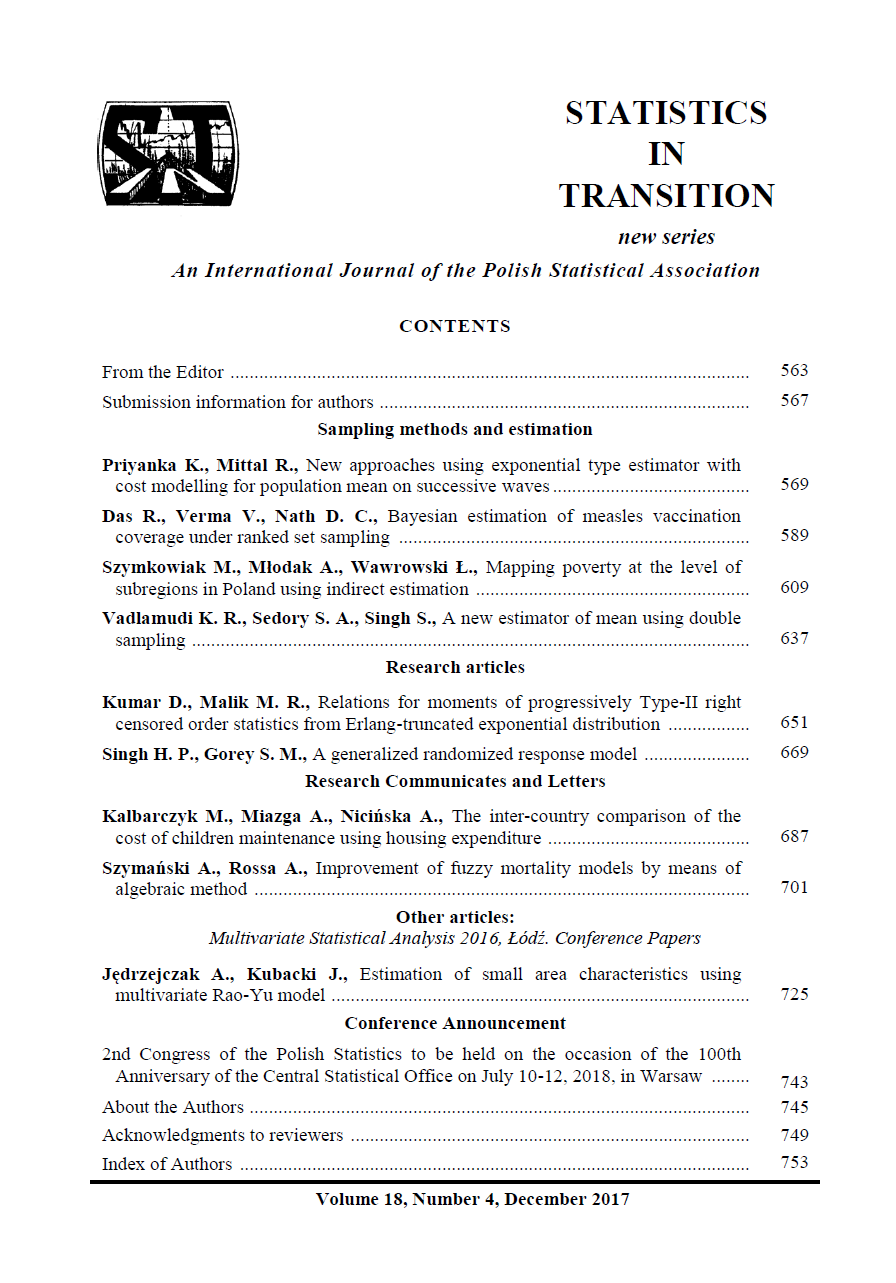ARTICLE
ABSTRACT
The present article is concerned with the problem of estimating an unknown population proportion p, say, of a certain population characteristic in a dichotomous population using the data collected through ranked set sampling (RSS) strategy. Here, it is assumed that the proportion p is not fixed but a random quantity. A Bayes estimator of p is proposed under squared error loss function assuming that the prior density of p belongs to the family of Beta distributions. The performance of the proposed RSS-based Bayes estimator is compared with that of the corresponding classical version estimator based on maximum likelihood principle. The proposed procedure is used to estimate measles vaccination coverage probability among the children of age group 12-23 months in India using the real-life epidemiological data from National Family Health Survey-III
KEYWORDS
Bayes estimator, maximum likelihood principle, square error loss, risk function and immunization coverage.
REFERENCES
BERGER, J. O., MORENO, E., PERICCHI, L. R., BAYARRI, M. J., BERNARDO,J. M., CANO, J. A., ... and DASGUPTA, A., (1994). An overview of robustBayesian analysis. Test, 3 (1), pp. 5–124.
CHEN, H., (2008). Alternative Ranked set Sample Estimators for the Variance of a Sample Proportion ,Applied Statistics Research Progress; Nova Publishers, pp. 35–38.
CHEN, Z., BAI, Z. D., SINHA, B. K., (2004). Ranked Set Sampling: Theory and Applications, Lecture Notes in Statistics, 176, Springer-Verlag, New York.
CHEN, H., STASNY, E. A., WOLFE, D. A., (2005). Ranked Set Sampling for Efficient Estimation of a Population Proportion Statistics in Medicine, 24,pp. 3319–3329.
CHEN, H., STASNY, E. A., WOLFE, D. A., (2006). Unbalanced Ranked Set Sam pling for Estimating a Population Proportion, Biometrics, 62, pp. 150–158.
CHEN, H., STASNY, E. A., WOLFE, D. A., (2007). Improved Procedures for Estimation of Disease Prevalence Using Ranked Set Sampling, Biometrical Journal, 49 (4), pp. 530–538.
CHEN H. , STASNY A. E., WOLFE A. D., MACEACHERN N. S., (2009). Un balanced Ranked Set Sampling for Estimating A Population Proportion Under Imperfect Rankings, Communications in Statistics - Theory and Methods,38 (12), pp. 2116–2125.
FERRARI, S., CRIBARI-NETO, F., (2004). Beta regression for modelling rates and proportions. Journal of Applied Statistics, 31 (7), pp. 799–815.
FERGUSON, T. S., (2014). Mathematical statistics: A decision theoretic approach (Vol. 1) Academic press.
FUQUENE P.J.A., COOK, J.D., PERICCHI, L. R., (2008). A Case for Robust Bayesian priors with Applications to Binary Clinical Trials,http://biostats.bepress.com/mdandersonbiostat/paper44
GEMAYEL, N. M., STASNY, E. A., TACKETT, J. A., WOLFE, D. A., (2012).Ranked set sampling: an auditing application, Review of Quantitative Finance and Accounting, 39 (4), pp. 413–422.
GUPTA, A. K., NADARAJAH, S. (Eds.), (2004). Handbook of beta distribution and its applications. CRC press.
JOZANI, M.J., MIRKAMALI, S. J., (2010). Improved attribute acceptance sam pling plans based on maxima nomination sampling, Journal of Statistical Plan ning and Inference, 140 (9), pp. 2448–2460.
JOZANI, M. J., MIRKAMALI, S. J., (2011). Control charts for attributes with maxima nominated samples, Journal of Statistical Planning and Inference, 141, pp. 2386–2398.
KVAM, H. P., (2003). Ranked Set Sampling Based on Binary Water Quality Data With Covariates, Journal of Agricltural, Biological and Environmental Statis tics, 8 (3), pp. 271–279.
LACAYO, H., NEERCHAL, N. K., SINHA, B. K., (2002). Ranked Set Sampling from a Dichotomous Population, Journal of Applied Statistical Science, 11(1),pp. 83–90.
MCINTYRE, G. A., (1952). A method for unbiased selective sampling, using ranked sets, Australian Journal of Agricultural Research, 3, pp. 385–390.
NFHS-III., (2005-2006). National Family Health Survey", International Institute for Population Sciences, Bombay.
PAOLINO, P., (2001). Maximum likelihood estimation of models with beta-distributed dependent variables, Political Analysis, pp. 325–346.
PERRY, T. R., HALSEY, A. N., (2004). The Clinical Significance of Measles: A Review" The Journal of Infectious Diseases, 189, Suppl 1: S4–16.
PHAM-GIA, T., (1994). Value of the beta prior information, Communications in Statistics - Theory and Methods, 23 (8), pp. 2175–2195.
STOKES, L. S., (1977). Ranked Set Sampling with Concomitant variables, Com munications in Statistics - Theory and Methods, 6 (12), pp. 1207–1211.
TERPSTRA, J. T., (2004). On Estimating a Population Proportion via Ranked Set Sampling, Biometrical Journal, 2, pp. 264–272.
TERPSTRA, J. T., LIUDAHL, L. A., (2004). Concomitant-based Rank Set Sam pling Proportion Estimates, Statistics in Medicine, 23, pp. 2061–2070.
TERPSTRA, J. T., MILLER, Z. A., (2006). Exact Inference for a Population Pro portion Based on a Ranked Set Sample, Communications in Statistics: Simu lation and Computation, 35 (1), pp. 19–27.
TERPSTRA, J. T., NELSON, E. J., (2005). Optimal Rank Set Sampling Estimates for a Population Proportion, Journal of Statistical Planning and Inference, 127, pp. 309–321.
WANG, C., BLEI, D. M., (2015). A general method for robust Bayesian modeling, arXiv preprint arXiv:1510.05078.
WOLFE, D. A., (2010). Ranked set sampling, Wiley Interdisciplinary Reviews: Computational Statistics, 2 (4), pp. 460–466.
WOLFE, D. A., (2012). Ranked set sampling: its relevance and impact on statisti cal inference, ISRN Probability and Statistics.
ZAMANZADE, E., MAHDIZADEH, M., (2017). A more efficient proportion es timator in ranked set sampling, Statistics & Probability Letters, pp. 28–33.
ZAMANZADE, E., MAHDIZADEH, M., (2017). Estimating the population pro portion in pair ranked set sampling with application to air quality monitoring, Journal of Applied Statistics, pp. 1–12.
